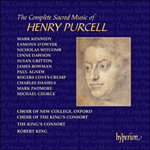William Fuller’s ‘divine hymn’ Lord, what is man? was set by Purcell during 1693, and published in volume 2 of Harmonia Sacra – the volume which also contains ‘The Blessed Virgin’s Expostulation’. Like that work, Lord, what is man? begins with an extended passage of semi-recitative, full of intricate vocal touches and subtle harmonic emphasis. The opening question is first asked gently, then repeated with more anxiety, the singer amazed that the son of God should become (with a wonderfully crafted melodic phrase) ‘a poor tormented man’. Man is ‘lost’ at the lower end of the singer’s voice, the Son of God’s glory rises optimistically through the scale, only to ‘become a poor, tormented man’. The Deity is graphically ‘shrunk’ into a human lifespan, and ‘wondrous love’ blossoms magnificently. The singer calls on the ‘glorious spirits’ to say ‘which was more prevalent’ – their joy, pictured in a fine melisma, or the dropping interval that represents their astonishment. The contrast between the ‘worm’ that is man and the exalted position of God is vividly captured in the music.
An arioso section follows, calling for a quill ‘to write the praises’, and then, with Purcell inspired as ever at the mention of music, for ‘a voice like yours to sing that anthem here which once you sung’. An extended section of alleluias closes the work: the compelling variety of moods and phrases create such an inexorable momentum that it is easy to forget Purcell is setting just one word.
from notes by Robert King ©
Cet 'Hymne Divin' de William Fuller fut mis en musique par Purcell en 1693, et publié dans le second volume de L’Harmonia Sacra — volume où figure également le motet Blessed Virgin s Expostulation. Comme celui-ci, Lord, what is man? (Seigneur, qu'est donc l'homme?) commence sur un long passage semi-récitatif foisonnant de petites touches vocales compliquées et de subtils accents harmoniques. La question initiale est tout d'abord posée avec calme, puis répétée sur un ton plus anxieux, la chanteuse trouvant surprenant que le fils de Dieu puisse devenir (avec une phrase mélodique merveilleusement construite) 'un pauvre homme tourmenté'. L'homme est 'perdu' dans le registre grave de la voix, tandis que la gloire du fils de Dieu s'élève avec optimisme le long de l'échelle musicale avant qu'il devienne ce 'pauvre homme tourmenté'. La déité se 'rétrécit' de manière graphique en une courte vie humaine, et T'amour merveilleux' s'épanouit avec majesté. La chanteuse somme les 'esprits glorieux' de lui dire 'ce qui l'emporta' de leur joie, dépeinte par un élégant mélisme, ou de leur étonnement, représenté par un intervalle descendant. Le contraste entre le 'ver' qu'est l'homme et la place élevée de Dieu est particulièrement bien rendu par la musique. Suit alors une section arioso quémandant une penne 'pour écrire les louanges', puis, avec l'inspiration que Purcell savait toujours trouver lorsqu'était citée la musique, 'une voix comme la tienne pour chanter cet hymne ici-bas que tu chantas jadis aux cieux'. Le motet s'achève sur une longue section d'alléluias; son extraordinaire variété de sentiments et de phrases donne à cette conclusion un élan si inexorable qu'on en oublie facilement que Purcell se concentre ici sur seul mot.
extrait des notes rédigées par Robert King © 1993
Français: Jean-Paul Metzger
William Füllers 'göttliche Hymne' 'Herr, was ist der Mensch?' wurde von Purcell im Jahre 1693 vertont und in Band 2 der Harmonia Sacra veröffentlicht, in dem Band, der auch die Blessed Virgin 's Expostulation enthält. Wie jenes Werk beginnt auch 'Herr, was ist der Mensch?' mit einem langen Semirezitativ voll komplizierter Stimmvariationen und feiner Harmoniebetonung. Die am Anfang gesungene Frage wird zunächst sanft gestellt und dann mit größerer Unruhe wiederholt, wobei die Sängerin Erstaunen darüber zum Ausdruck bringt (in einem wundervoll gearbeitetem melodischen Satz), daß Gott ein 'armer, gepeinigter Mensch' sein soll. Der Mensch gilt mit tief gesungener Stimme als 'verloren', der Sohn der Herrlichkeit Gottes steigt mit optimistischen Klängen die Tonleiter hinauf, um dann aber zum 'armen, gepeinigten Menschen' zu werden. Die Gottheit 'zwängt sich' dabei buchstäblich in ein menschliches Lebensalter, worauf die 'wunderbare Liebe' mit wundervoller Ausdruckskraft folgt. Die Sängerin bittet die 'herrlichen Geister', ihr zu sagen, was 'das Vortrefflichere' war — ihr Glück, in gelungenem Melisma ausgedrückt, oder die mit sinkender Stimmlage eingeleitete Pause, die ihr Erstaunen zum Ausdruck bringt. Die Musik fangt den Gegensatz zwischen dem 'Wurm', der der Mensch ist und der exaltierten Gottheit gekonnt ein. Der folgende Arioso-Abschnitt verlangt nach einer Feder 'um die ewige Liebe zu preisen' und dann — wobei Purcell mehr denn je durch die Erwähnung der Musik inspiriert zu sein scheint — nach 'einer Stimme wie die Eurige, um den Lobgesang anzustimmen'. Ein langer Halleluja-Teil beendet das Werk: die bezwingenden Stimmungs- und Satzvariationen entwickeln eine solche Eigendynamik, daß man leicht vergißt, daß Purcell hier nur ein Wort vertont hat.
aus dem Begleittext von Robert King © 1993
Deutsch: Margarete Forsyth


 Purcell: The Complete Sacred Music
Purcell: The Complete Sacred Music
